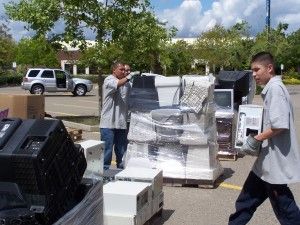State violates e-waste rules

March 31, 2010
By ANTHONY PIGNATARO
Despite a state Auditor’s report and a four-year-old law that prohibits consumers from throwing old and broken electronic devices into the trash, many state agencies are apparently still throwing computers, television sets, radios, printers, copiers, radios and cell phones into the trash rather than putting them through special recycling efforts, a CalWatchdog investigation shows.
Through the California Public Records Act, CalWatchdog obtained copies of all Property Survey Reports – which record in some detail the proposed disposition of state-owned property — filed by state agencies between July and December 2009. Because the Department of General Services receives between 1,000 and 1,200 such reports every month, the request ended up gathering between 6,000 and 7,200 individual records. From these, we were able to determine that 29 separate state agencies disposed of some kind of electronic device during that time period.
Of those agencies, 28 of them reported that they had declared electronic devices – many of which contain heavy metals and other potential toxics — to be “valueless,” meaning that they could be “legally/safely disposed of.” For instance, the property survey reports showed that between July and December 2009, the state Department of Corrections “legally/safely disposed of” 228 television sets or computer monitors, 235 desktop or laptop computers, 127 printers or copiers, 13 phones and two microwave ovens. All of the equipment was classified as “junk.”
The Department of Corrections’ public affairs office didn’t respond to call for comment by press time.
“There are probably many reasons for this,” Teresa Bui, a policy associate at the non-profit environmental advocacy group Californians Against Waste who was familiar with the issue of state e-waste issues, said. “Mostly I think people just didn’t know that they need to properly recycle. There may not be a contract with a recycler. Or it’s just easier to throw it in the trash.”
For its part, the Department of General Services insists that state agencies are recycling old and unwanted electronic devices, but that many agencies simply aren’t properly reporting the recycling on the property survey reports. “I think there’s room for improvement as to how they report this on the forms,” General Services spokesman Eric Lamoureaux said. “We’ve been focused on this over the last two years. Between June and December of 2009 we recycled 74,000 tons of electronic waste.”
Lamoureaux admitted there is often a “disconnect” between how agencies fill out the survey reports and what actually becomes of the old devices, but added that many times General Services will alert departments that classifies electronic devices as trash to change their disposition codes on the property survey report. Lamoureaux had no explanation when CalWatchdog found no instance of new recycling codes being added to the survey reports obtained through the Public Records Act.
Indeed, just a handful of agencies reported recycling obsolete or non-working electronic devices. In most cases, the agencies exhibited a kind of split personality where electronic devices were concerned – sending some off to a recycler while tossing others in the trash.
In all cases, the numbers of devices the agencies reported recycling paled before those they trashed. For instance, the state Department of Forestry and Fire’s Santa Cruz office classified nine computers, eight television sets and eight other devices as “Donation to Scrap/Salvage Dealer (To be recycled)” while the rest of the department’s offices reported junking 137 computers, 23 televisions, 42 printers, 50 cell phones, seven laptop batteries and one microwave oven.
A new disposition classification, “Universal Waste – Salvage Dealer, Recycler (E-Waste),” is apparently in use, though in the records CalWatchdog examined, only the Department of General Services – which manages the disposition forms in the first place – used it. Between August and December 2009, General Services reported four computer hard drives and three tapes as disposed under this E-Waste classification and another two “data modems” disposed to a scrap/salvage dealer. But the department also reported three printers and a copier as bound for the trash.
In any case, the apparent “disconnect” between the thousands of property survey reports generated every month and the actual disposition of state property raises serious questions about both the value of the reports and the efficacy of state recycling efforts. For that reason, last month Sen. Jenny Oropeza, D-Long Beach, introduced SB1052, which would attempt to rationalize state e-waste recycling efforts. It would also assign the Department of Toxic Substances Control to watchdog the rest of state government on the recycling of old electronic devices.
“The disposal of electronic waste is currently overseen by a confusing jumble of state agencies,” Oropeza said in a Feb. 16 press release on SB1052, which will come up for hearing on April 5. “In this economic crunch, where we are trying to maintain quality standards with less money, it is simply dumb to assign the same duty to so many agencies. Streamlining this process would not only help protect the environment and public health, but also would result in better use of taxpayer funds.”
Lamoureaux, who said he had not heard of SB1052, had no comment on the proposed legislation.
The numbers of electronic devices headed to the trash every year are staggering. “Americans own nearly 3 billion electronic products,” states a 2007 Environmental Protection Agency fact sheet. “For each new product that comes along, one or more becomes outdated or obsolete.”
An aide to Oropeza said the inspiration for the bill was a 2008 state Auditor’s review of property survey reports that also seemed to indicate huge numbers of state-owned computers, televisions and other devices were ending up in the trash. One of the Auditor’s recommendations was to develop an overall effort to keep electronic waste out of landfills.
“This report concludes that a lack of clear communication from oversight agencies, coupled with some state employees’ lack of knowledge about e-waste, contributed to state agencies improperly disposing of some electronic devices in the trash,” Auditor Elaine M. Howle wrote in a Nov. 18, 2008 letter that preceded the report on e-waste. “Finally, our review found that state and local oversight of e-waste is infrequent and may not always identify instances when state agencies improperly dispose of e-waste.”
The numbers of electronic devices potentially bound for landfills is staggering. In 2005, the EPA estimated that in 26 million to 37 million computers become obsolete. That same year, Americans stopped using an estimated 130 million cell phones (the average life of a cellular phone, because of steadily accumulating new features, provider compatibility and quality control is a mere year and a half). Put another way, Americans quit using 1.9 million to 2.2 million tons of electronic devices. Of that, the vast majority – 1.5 million to 1.8 million tons – ended up in the trash, according to the EPA.
Electronic devices like computers and television monitors pose special dangers for landfills. According to the EPA, they contain numerous toxins, including lead (used in glass cathode ray tubes), mercury (from laptop monitor screens), brominated flame retardants (from plastic cases and cables) and cadmium (from older laptop batteries). Cell phones, though small, contain many different types of metals: copper, iron, nickel, silver, zinc, aluminum, gold, lead, manganese, palladium, platinum and tin, according to the United States Geological Survey.
Elise Viebeck provided research assistance for this story.
Related Articles
DOJ advisory groups violate open meetings requirements
A subcommittee inside the California Department of Justice is accused of meeting in violation of the state’s open meetings act
East Coast front opens in Filner war on women
Wednesday was a very bad day for Bob Filner, who was purportedly in his third day of an intensive two-week
What’s being ignored in the Calderon scandals
It’s interesting to see what stories the big newspapers choose to run, and more interesting to see what they ignore.




